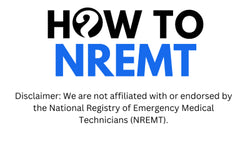Pass the NREMT Cognitive Exam with Confidence: EMT Tutors and Prep Tips for Connecticut
Earning your EMT certification in Connecticut is an exciting goal, and you don’t have to go it alone. Connecticut requires candidates to complete state-approved education and pass both national and state exams, including the NREMT cognitive exam.
As your trusted NREMT Prep Tutor, we’ll break down each step, eligibility, training, testing, and application. We will also explain how HowTo NREMT’s supportive 10-step plan, AI tutoring, and practice tools make success much easier.
Step 01

Meet Basic Eligibility Requirements
To start your EMT journey in Connecticut, you must:
- Be at least 16 years old
- Hold a high school diploma or GED (typically required for training programs)
- Be physically and emotionally fit for emergency care
- Have a valid driver’s license
- Disclose any criminal history during application (no fingerprinting required; reviewed case-by-case by CT DPH)
Note: You must also pass a background check when applying for the National Registry (NREMT).
Step 02

Complete a State-Approved EMT Training Program
Connecticut mandates completion of a CT OEMS-approved EMT course with a minimum of 150 hours of instruction. Most programs exceed this with 200–250 hours to better prepare students. This is where choosing the right EMT national training program becomes important.
Top Training Programs:
- CT State Community Colleges – 150-hour OEMS-certified EMT courses
- Yale New Haven Hospital – Center for EMS – ~200-hour course, includes NREMT prep
- Hartford HealthCare EMS Institute – 250-hour program, includes a free skills exam attempt
Courses blend classroom instruction, hands-on labs, and clinical or ride-along experiences to fully prepare students for real-world care.For added support, many students benefit from connecting with experienced EMT tutors to solidify their understanding of the material.
Step 03

Obtain a CPR/BLS Certification
Connecticut requires EMTs to hold a Basic Life Support (BLS) CPR card for Healthcare Providers with hands-on evaluation.
- Accepted: AHA BLS or CAPCE-accredited courses with in-person skills testing
- Not Accepted: Fully online-only CPR certifications
Many EMT courses include CPR certification as part of the curriculum.
Step 04

Pass the National Registry Cognitive Exam (NREMT)
All Connecticut EMT candidates must pass the NREMT cognitive exam, which was updated in April 2025. It now includes:
- Scene Size-Up & Safety (15–19%) – preparing for the scene, managing hazards, PPE, and triage.
- Primary Assessment (39–43%) – initial patient assessment (consciousness, airway, breathing, circulation, vital signs).
- Secondary Assessment (5–9%) – detailed exam, and patient history to refine treatment.
- Patient Treatment & Transport (20–24%) – managing body systems, administering meds, moving patients, and communicating care.
- Operations (10–14%) – equipment readiness, documentation, responder health/safety.
Despite the new labels and content ratios, much of what you’ve studied still applies – questions are simply re-grouped to emphasize real-world decision-making. The exam also now includes Technology-Enhanced Items (TEIs) like drag-and-drop and multi-select questions. Be sure your study plan covers these interactive question types.
How To NREMT Makes It Easy:
Our program is built around the 5 domains above, with practice questions and masterclass videos for each.
- 10-step structurezd study plan tailored to the new 2025 exam
- 2,000+ exam-style questions including TEIs
- NREMT-style simulator scoring out of 1500
- AI Tutor “Ask Mr. How To” available 24/7 for help with concepts
- Flashcards, videos, and live Zoom coaching sessions
- 100% of students who completed our 10-step plan passed the NREMT.
Step 05

Pass Connecticut’s Psychomotor (Skills) Exam
You must also pass the state-approved psychomotor exam, which evaluates hands-on EMT skills such as:
- Patient assessment
- Bleeding control
- CPR procedures
- Airway management
Check the CT DPH website for available test dates at local colleges and EMS centers.
Step 06

Apply for Your Connecticut EMT License
Once you pass both exams and complete training, apply through the Connecticut eLicense system. Required documents include:
- Online application + fee
- Training Completion Form (sent by instructor)
- NREMT results
- Psychomotor Exam form
- Parental consent form (if under 18)
- Certification verification (if previously certified elsewhere)
CT DPH will review your submission and notify you of your certification status.
National vs. Connecticut Requirements
| Requirement | National (NREMT) | Connecticut (State of CT) |
|---|---|---|
| Age | Generally 18+ (varies by state) | 16 years old minimum (with parental consent under 18) |
| Education | High school diploma/GED usually required | High school diploma/GED typically expected for entry to EMT programs |
| Training Program | Complete an accredited EMT course (~150 hrs) | Complete a CT OEMS-approved EMT course (min 150 hours including exam) |
| CPR Certification | BLS/Healthcare Provider with hands-on skills | Must have a Healthcare Provider BLS/CPR certificate (AED & skills eval) |
| Cognitive Exam | Pass the NREMT EMT exam (updated April 2025 domains) | Same NREMT EMT exam required (Connecticut mandates NREMT since 2020) |
| Psychomotor Exam | Often a state or local skills test (varies) | Must pass Connecticut’s OEMS-approved EMT skills exam |
| Background Check | FBI/state background fingerprint check via NREMT (if required by state) | DPH reviews criminal history under CGS 19a-14; serious convictions can bar licensure |
| Application/License | Apply through NREMT (for registry credential) | Apply for Connecticut EMT certification via CT eLicense with CT DPH |
Note: The National Registry no longer tests for ALS psychomotor skills as of 2022. The skills requirements are only state-based.

- Choosing a selection results in a full page refresh.


